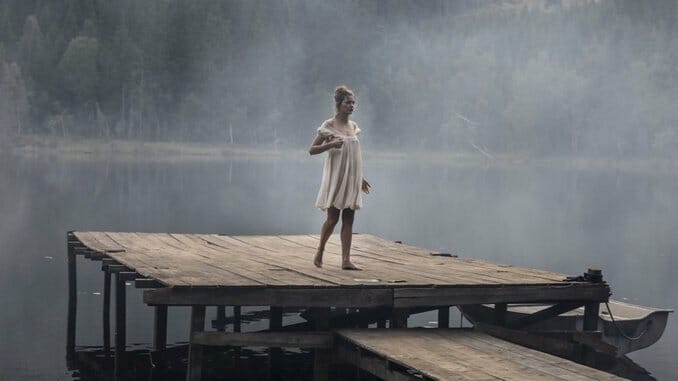Shudder’s Lake of Death Loses Itself in Its Influences

At times, horror movies can feel like a never-ending series of homages to predecessors. Especially within distinct subgenres, there must always be room for acknowledging those that pushed boundaries and perfected scares. Often this is achieved through re-imagining scenes, alluding to specific scares or, more directly, showing The Exorcist playing on a screen within the film itself. Much less frequently, thankfully, it might be explored through characters constantly and clunkily bringing up horror films that somewhat mirror their current unsettling experiences.
Norwegian director Nini Bull Robsahm’s Lake of Death is littered with references to immensely popular horror films. The Shudder Exclusive is actually a remake of the 1958 horror film Lake of the Dead (De dødes tjern), which itself was based on André Bjerke’s 1942 novel of the same name. Titles ranging from Misery, A Nightmare of Elm Street, Cabin Fever and The Evil Dead are referenced and directly quoted by characters, which unfortunately only serves to prompt comparisons between Lake of Death and some of the most enduringly popular horror films ever made.
The film follows Lillian (Iben Ackerlie) as she returns to the lakeside cabin where her twin brother, Bjørn (Patrick Walshe McBride), mysteriously disappeared one year earlier. Joining her are friends Sonja (Sophia Lie), Harald (Elias Munk), Gabriel (Jonathan Harboe), Bernhard (Jakob Schøyen Andersen) and Kai (Ulric von der Esch). Lillian and her now-estranged boyfriend Kai were the last people to see Bjørn before his disappearance the previous summer, and the guilt surrounding that fact has manifested for Lillian in bouts of sleepwalking. As the group stays in the cabin—and swim in the murky blue waters of the lake it sits on—an unknown force begins to terrorize them.
From the start, Lake of Death seems more concerned with making quips about horror film plots than constructing one of its own. In fact, the amount of lip service the film gives to other horror movies might momentarily cause the viewer to wonder if some Cabin in the Woods-level meta reveal is coming—but no. Instead, we start with a half-baked Blair Witch Project comment and eventually arrive at the point where a character discovers a secret basement in the cabin and says, “Wow, just like The Evil Dead!”
-

-

-

-

-

-

-

-

-

-

-

-

-

-

-

-

-

-

-

-

-

-

-

-

-

-

-

-

-

-

-

-

-

-

-

-

-

-

-

-








































